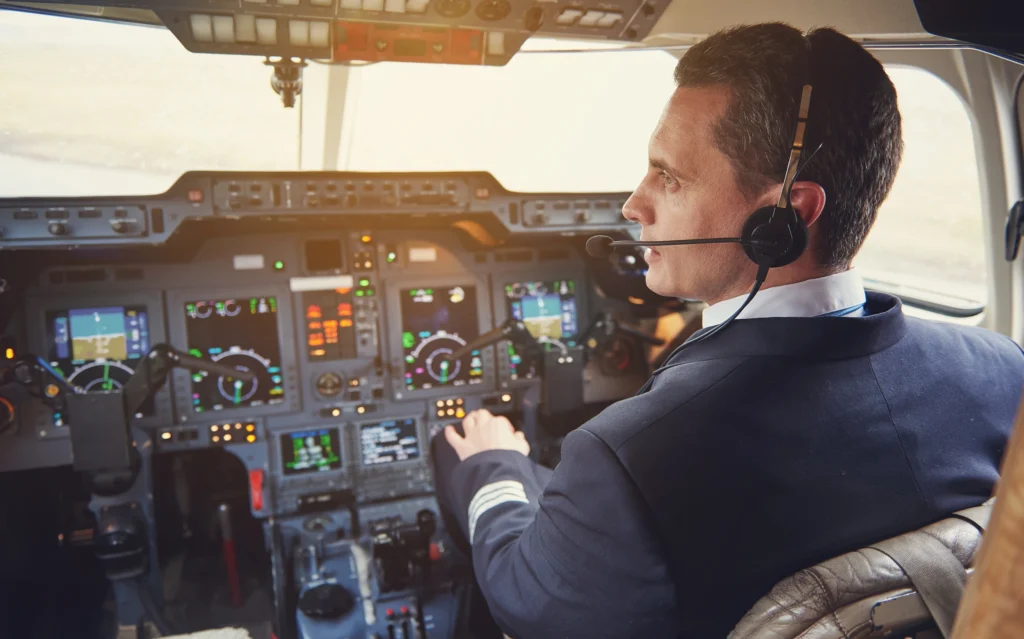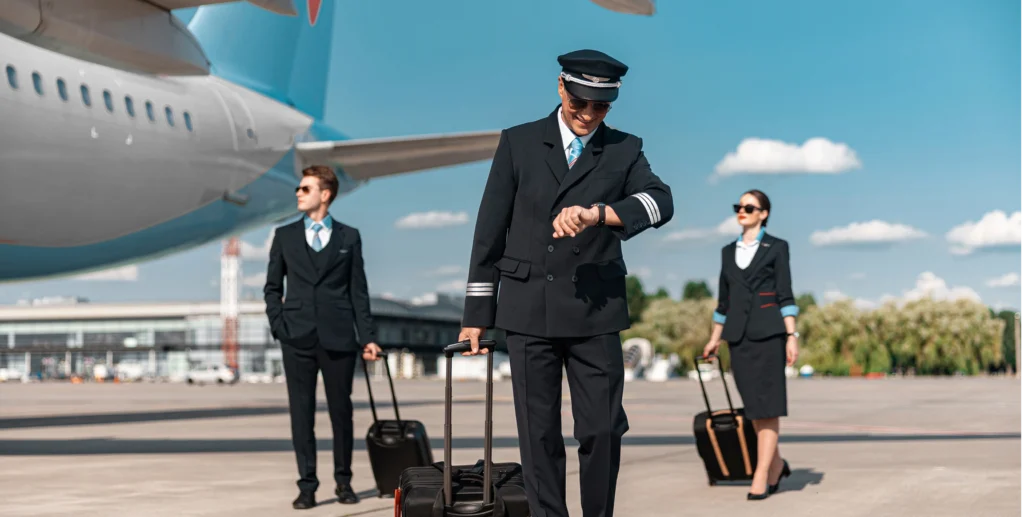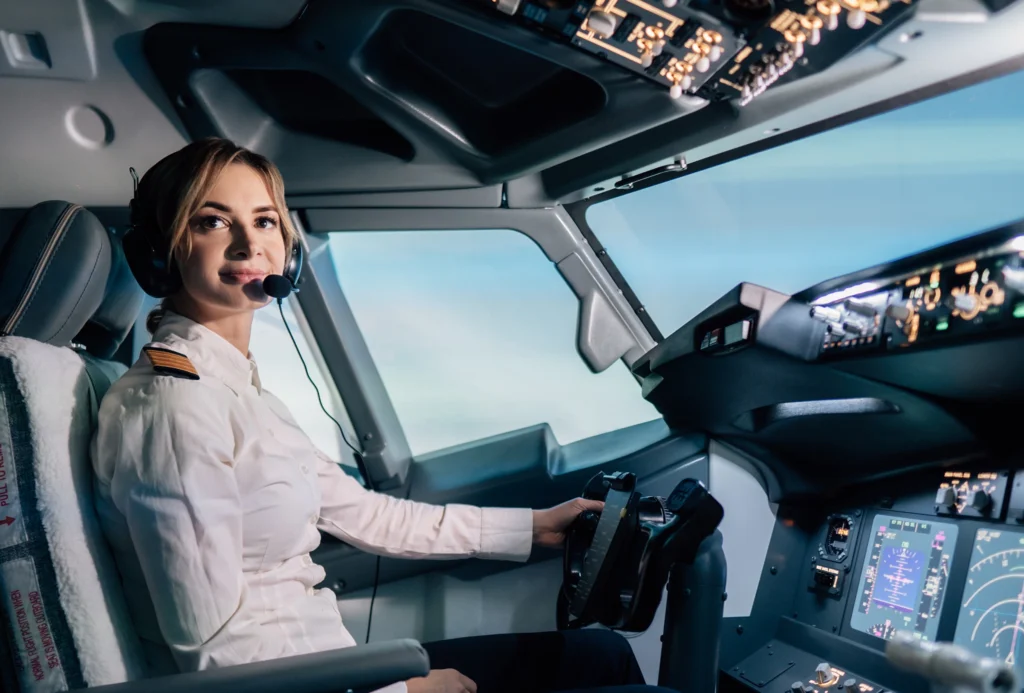La Licencia de Piloto de Tripulación Múltiple (MPL) es una certificación especializada diseñada para preparar a los individuos para desempeñarse como copilotos en operaciones de transporte aéreo comercial. A diferencia de las rutas tradicionales de formación de pilotos, la MPL se centra en una formación basada en competencias, adaptada al entorno de tripulación múltiple de las aeronaves modernas. Este enfoque pone énfasis en el desarrollo de habilidades necesarias para el trabajo en equipo eficaz, la gestión de amenazas y errores, y el uso competente de tecnologías avanzadas de simulación de vuelo.
Es importante destacar que la MPL está reconocida por todos los Estados contratantes de la OACI, incluso si no la establecen como una licencia nacional. Sin embargo, la implementación y aceptación de la MPL puede variar según el país, y algunas regiones pueden no ofrecer esta vía. Por ejemplo, aunque la MPL está disponible en muchos países europeos, no se emite en Estados Unidos ni en Canadá.

La Licencia de Piloto de Tripulación Múltiple (MPL) difiere significativamente de las licencias tradicionales de piloto, como la Licencia de Piloto de Transporte de Línea Aérea (ATPL) o la Licencia de Piloto Comercial (CPL), principalmente en su enfoque y estructura de formación. La MPL está diseñada específicamente para operaciones de aerolíneas y se centra en una formación basada en competencias dentro de un entorno de tripulación múltiple desde el inicio. A diferencia de las licencias tradicionales, que requieren que los pilotos acumulen horas de vuelo en solitario en aeronaves pequeñas antes de pasar a aviones comerciales, el programa MPL integra simuladores de vuelo completos y formación específica de aerolínea desde las primeras etapas, asegurando que los pilotos sean competentes en la operación de aeronaves complejas en escenarios reales.
Otra diferencia clave es que la MPL está patrocinada por una aerolínea y adaptada a una compañía específica. Los candidatos suelen realizar la formación bajo la supervisión de una aerolínea y, al finalizar, pasan directamente a desempeñar el rol de copiloto. En cambio, las licencias tradicionales, como la ATPL, ofrecen una vía más flexible, permitiendo a los pilotos adquirir experiencia a través de diversos trabajos de vuelo antes de postularse a una aerolínea. Esto convierte a la MPL en una ruta más directa pero especializada hacia las operaciones de aerolínea, con énfasis en el trabajo en equipo y la automatización, en lugar de la experiencia de vuelo en solitario.
La Licencia de Piloto de Tripulación Múltiple (MPL) y el curso de Cooperación en Tripulación Múltiple (MCC) cumplen funciones distintas en la formación de pilotos. La MPL es un programa completo de formación que lleva a un cadete desde cero experiencia de vuelo hasta convertirse en primer oficial cualificado para una aerolínea específica. Este programa pone énfasis en la formación basada en competencias, el uso intensivo de simuladores de vuelo de última generación y las operaciones en tripulación múltiple desde el inicio. Por otro lado, el curso MCC es un programa breve pero esencial, diseñado para pilotos que ya han obtenido una Licencia de Piloto Comercial (CPL) o una Licencia de Piloto de Transporte de Línea Aérea (ATPL) y necesitan hacer la transición de operaciones en solitario a un entorno de tripulación múltiple.
En Global Training Aviation (GTA), estamos especializados en ofrecer el curso MCC, proporcionando a los pilotos las habilidades necesarias para operar de forma segura y eficiente en una cabina con tripulación múltiple. Nuestra formación MCC se centra en el trabajo en equipo, la comunicación, la gestión de la carga de trabajo y la toma de decisiones, asegurando que los pilotos estén completamente preparados para las operaciones en aerolínea. Aunque la MPL incorpora los principios del MCC dentro de su plan de estudios más amplio, en GTA nuestra especialidad es ofrecer formación MCC de alta calidad como un paso clave para los pilotos que se adentran en el mundo de la aviación comercial.


El programa de formación para la Licencia de Piloto de Tripulación Múltiple (MPL) sigue un enfoque estructurado y basado en competencias, diseñado para preparar a los cadetes para operaciones en aerolíneas desde el principio. A diferencia de la formación tradicional de pilotos, que comienza con vuelos en solitario en aeronaves pequeñas, la formación MPL pone énfasis en la cooperación en tripulación múltiple, la gestión de amenazas y errores, y los procedimientos específicos de aerolínea.
El programa consta de cuatro fases:
Para obtener una MPL, los alumnos deben completar un mínimo de 240 horas de vuelo, la mayoría de ellas en simuladores en lugar de aeronaves reales. Además, deben recibir al menos 750 horas de instrucción teórica, que abarca áreas como meteorología, navegación y factores humanos.
La MPL se emite en colaboración con una aerolínea, lo que significa que los cadetes suelen tener garantizado un puesto como primer oficial al completar con éxito el programa.
Formación Específica para Aerolíneas: Los cadetes del programa MPL se entrenan en un entorno de tripulación múltiple desde el principio, utilizando simuladores avanzados y procedimientos específicos de aerolínea, en lugar de comenzar con vuelos en solitario en aeronaves pequeñas.
Transición Más Fluida a las Operaciones de Aerolínea: La formación está diseñada para desarrollar las habilidades necesarias para las operaciones comerciales, asegurando que los cadetes estén bien preparados para escenarios del mundo real.
Eficiencia y Acceso Rápido al Empleo: Dado que los programas MPL se desarrollan en colaboración con aerolíneas, los graduados suelen obtener un puesto como primer oficial inmediatamente después de finalizar la formación, evitando la incertidumbre de buscar empleo.
Menor Requisito de Horas de Vuelo: A diferencia de la ruta tradicional del ATPL, que exige 1.500 horas antes de poder actuar como comandante, la MPL permite a los cadetes cualificarse con un mínimo de 240 horas de vuelo, la mayoría realizadas en simuladores.
Rentable y Orientado a la Carrera Profesional: La estructura simplificada del MPL lo convierte en una vía más directa y financieramente eficiente para ingresar en la aviación comercial.

Aunque la Licencia de Piloto de Tripulación Múltiple (MPL) ofrece una vía rápida hacia las operaciones en aerolínea, también presenta ciertos desafíos y consideraciones:
Flexibilidad Limitada: La formación MPL está diseñada para una aerolínea específica, lo que significa que los pilotos se entrenan para una compañía concreta. Si necesitan cambiar de aerolínea o de región, convertir la MPL a otra licencia puede ser un proceso complejo.
Menor Experiencia de Vuelo Tradicional: Dado que la mayor parte de la formación se realiza en simuladores en lugar de aeronaves reales, los cadetes MPL pueden tener menos experiencia práctica de vuelo en comparación con quienes siguen la ruta tradicional del ATPL.
Dependencia Laboral: Los cadetes MPL suelen estar vinculados a la aerolínea que patrocina su formación. Si esa aerolínea enfrenta dificultades financieras o congela contrataciones, la incorporación laboral puede volverse incierta.
Limitaciones Regulatorias: La MPL no está reconocida en todos los países, por lo que los pilotos pueden enfrentar obstáculos si desean trabajar en regiones donde esta licencia no es aceptada.
La Licencia de Piloto de Tripulación Múltiple (MPL) abre una variedad de oportunidades profesionales, principalmente dentro de la industria de las aerolíneas. Dado que la formación MPL está orientada a una aerolínea específica, los graduados suelen tener garantizado un puesto como primer oficial con la aerolínea patrocinadora, lo que facilita la transición hacia la aviación comercial. Esto proporciona una vía directa para volar aeronaves de mayor tamaño en un entorno de tripulación múltiple, con frecuencia con oportunidades de ascenso rápido a medida que el piloto adquiere experiencia y antigüedad.
Además, aunque los pilotos con MPL están inicialmente vinculados a su aerolínea patrocinadora, su formación les proporciona las habilidades necesarias para progresar dentro del sector, con la posibilidad de ascender a puestos de comandante en el futuro. Algunas aerolíneas también pueden ofrecer oportunidades para pasar a otras operaciones de vuelo o a funciones de formación dentro de la compañía.
Sin embargo, es importante tener en cuenta que la MPL está más enfocada al empleo en aerolíneas, lo que significa que las oportunidades laborales fuera de este sector pueden ser más limitadas en comparación con los graduados de la vía tradicional del ATPL.
La principal diferencia entre una Licencia de Piloto Comercial (CPL) y una Licencia de Piloto de Tripulación Múltiple (MPL) radica en el enfoque de la formación, los requisitos y la trayectoria profesional. Una CPL permite a los pilotos operar como pilotos comerciales, pero no está especializada en operaciones con tripulación múltiple. La formación para la CPL es más general y abarca vuelos en solitario, horas de vuelo en aeronaves pequeñas y preparación para una amplia gama de trabajos de vuelo, incluyendo vuelos corporativos y chárter. En cambio, la MPL está diseñada específicamente para pilotos que desean trabajar en operaciones de aerolínea como primer oficial. La formación MPL se centra en la cooperación en tripulación múltiple desde el inicio, utilizando simuladores y procedimientos específicos de aerolínea para preparar a los pilotos para trabajar en un entorno comercial.
En cuanto a las horas de vuelo, la CPL requiere un mínimo de 200 a 250 horas, incluyendo tiempo en solitario en aeronaves pequeñas, mientras que la MPL requiere menos horas totales de vuelo —normalmente alrededor de 240 horas, con un mayor énfasis en el tiempo en simuladores y escenarios específicos de aerolínea. En lo que respecta a las trayectorias profesionales, una CPL permite a los pilotos postularse a una variedad de trabajos comerciales en distintos sectores, aunque necesitarán formación adicional, como la Licencia de Piloto de Transporte de Línea Aérea (ATPL), para pasar a operaciones de aerolínea. La MPL, por otro lado, ofrece una vía más directa hacia las operaciones en aerolínea, y la mayoría de los graduados son contratados directamente por la aerolínea patrocinadora como primeros oficiales al finalizar el programa.
En resumen, mientras que la CPL ofrece mayor flexibilidad y acceso a una variedad de carreras en la aviación, la MPL está orientada específicamente a quienes desean convertirse en pilotos dentro de una aerolínea, proporcionando una ruta más estructurada y directa hacia la industria aérea.
La elección entre la ATPL y la MPL depende de tus objetivos profesionales. La ATPL es la vía tradicional y ofrece mayor flexibilidad, ya que permite trabajar en diversos sectores de la aviación antes de llegar a ser comandante en una aerolínea. Requiere más horas de vuelo y experiencia, pero brinda más opciones de carrera.
Por otro lado, la MPL está diseñada específicamente para quienes desean convertirse en pilotos de aerolínea. Se centra en operaciones con tripulación múltiple y formación específica de aerolínea, lo que permite convertirse en primer oficial más rápidamente. Sin embargo, la MPL es más restrictiva, ya que está orientada exclusivamente a carreras en aerolíneas, mientras que la ATPL ofrece más oportunidades fuera de este sector. Si buscas una vía más rápida hacia una aerolínea, la MPL es ideal; si prefieres mayor flexibilidad, la ATPL es la mejor opción.
Un piloto de tripulación múltiple es un piloto que opera una aeronave como parte de un equipo, normalmente compuesto por un comandante y un primer oficial, en un entorno de cabina compartida. En este sistema, ambos pilotos tienen funciones y responsabilidades distintas, pero trabajan en conjunto para garantizar una operación segura y eficiente del vuelo. El comandante está a cargo del vuelo en general, mientras que el primer oficial asiste en tareas como la comunicación, la navegación y la supervisión de los sistemas.
Las operaciones con tripulación múltiple son estándar en la aviación comercial, donde las aeronaves son grandes y complejas, lo que requiere más de un piloto para gestionar el vuelo. Este sistema permite una división de tareas, lo que ayuda a reducir la carga de trabajo, aumenta la seguridad y asegura que ambos pilotos puedan apoyarse mutuamente durante las fases críticas del vuelo. El rol del piloto de tripulación múltiple es esencial para gestionar estas tareas y tomar decisiones colaborativas en situaciones de alta presión.
En conclusión, la Licencia de Piloto de Tripulación Múltiple (MPL) es una opción ideal para quienes buscan una carrera rápida y especializada en la aviación comercial, con un enfoque en operaciones con tripulación múltiple desde el inicio.
¡Vamos a empezar!
Deja tus datos de contacto y nos pondremos en contacto contigo
CURSO INICIAL TCP
Renovación